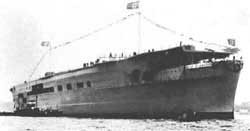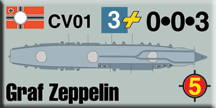| Germany’s Aircraft
Carrier
By Mike Bennighof, Ph.D.
August 2021
 During the First World War, Germany lagged behind her rivals
in sending aircraft to sea. No warship carried seaplanes during
the early years of World War One, but both Russia
and Britain converted liners and other ships into very useful
seaplane carriers within a few months of the war’s outbreak. During the First World War, Germany lagged behind her rivals
in sending aircraft to sea. No warship carried seaplanes during
the early years of World War One, but both Russia
and Britain converted liners and other ships into very useful
seaplane carriers within a few months of the war’s outbreak.
Germany deployed some very slow freighters as seaplane tenders,
but these were used as mobile seaplane bases rather than actual
carriers. Only toward the war’s end were two cruisers
converted to hybrid seaplane carriers. In addition, naval
planners drafted a very sophisticated design to convert the
passenger liner Ausonia into an full-decked aircraft
carrier. However, nothing came of this plan and the Weimer
Republic’s navy lost interest in aircraft carriers.
Germany would not operate any aircraft carriers during the
next war, either, but it did try to build two of them and
almost completed one. This ship, the Graf Zeppelin, appears
in Second World War at Sea: Bismarck along with her projected sister ship, Peter Strasser, with scenarios allowing players
to explore how aircraft carriers might have helped the German war
effort (hint: not much).

Graf Zeppelin shortly after launch.
When the Nazis came to power in 1933, they found that the Reichsmarine had
an expansion program already quietly under way. However, the
proposed fleet lacked aircraft carriers. Engineer Wilhelm
Hadeler, the 36-year-old wunderkind of German naval architects,
was tapped to draft a ship to fill this need, and he responded
with a plan for a 22,000-ton ship carrying 50 planes. She
would carry eight 8-inch guns in casemate mounts set rather
low on the hull, later replaced by double mounts with 5.9-inch
guns. While Hadeler’s design was somewhat backward in
its heavy armament, he foresaw later developments by including
a substantial anti-aircraft armament: 10 4.1-inch anti-aircraft
guns (Germany did not produce a dual-purpose naval gun until
very late in the war) and dozens of small-caliber automatic
weapons.
The Anglo-German Naval Agreement of 1935 allowed Germany to
build warships adding up to 35 percent of the total British
tonnage in each given category, and this caused Hadeler’s
design to be shelved. Instead, the Navy now wanted two aircraft
carriers of 19,500 tons each, to equal the allowable treaty
tonnage. The actual design came in at 23,450 tons. The anti-aircraft
armament now became 22 37mm guns and seven, eventually raised
to 28, of the same 20mm Oerlikon guns mounted on American
carriers (the looming war was already being very good to Swiss arms makers).
Designing a carrier frustrated the new German team, who
slipped a couple of engineers into the delegation visiting
Britain’s “Navy Week” in 1935. They snapped
pictures of the British carrier Glorious and even
wrangled a tour of her near-sister Furious. Both
ships had short flying-off decks in front of the main flight
deck, something missing from Hadeler’s design. The British
were already planning to give up this anachronism and mount
anti-aircraft weapons there, but the Germans never realized
this and fell into disagreement over whether their carrier
should have this feature as well.

Some weeks later, this was settled when the Japanese agreed
to give a tour of their carrier Akagi and access
to their naval architects. Akagi had just been moved
into Sasebo Navy Yard to remove her similar flying-off deck
and extend her flight and hangar decks forward. Japanese engineers
appear to have tried their best to help the Germans, handing
over over 100 blueprints of Akagi and apparently
of Soryu as well, then under construction in Kure.
With these lessons incorporated into the design, Flugzeugträger
A began construction (German practice did not recognize “keel
laying” as a significant milestone) on 26 December 1936
at Deutsche Werke in Kiel, taking over the slipway cleared
three weeks earlier by the launch of the battle cruiser Gneisenau. Per German practice, she did not officially receive a
name at first, and was later christened Graf Zeppelin in honor of the developer of airship travel.
By April 1940 she was 90 percent complete, but the engineers
still had not solved the problems of catapult design and arrester
gear. The ever-helpful Japanese could offer no assistance
this time: Japanese carriers did not use catapults, and the
Imperial Navy’s architects advised the Germans to forego
them as well. Air Force technical experts (a politically important
part of the design team, as the Luftwaffe controlled all that
flew in Germany’s military) insisted that a catapult
would be necessary to launch the heavier combat planes foreseen
in the future.
Flugzeugträger B (following both Imperial and Weimar
practice, the Nazi navy assigned letter codes to additions
to fleet strength, and Ersatz or “Replacement”
names to those ships replacing old units) began construction
in 1938 at Germaniawerft, another private yard in Kiel, on
the slipway vacated by the cruiser Prinz Eugen. German
engineers planned to build her more slowly than Graf Zeppelin, to take advantage of any lessons learned from building
the first carrier. Though never officially named, all understood
that this second ship would be called Peter Strasser, after the head of the German Naval Airship Division who
died while bombing England in 1918.

Launching the carrier.
Two more carriers of the same design, prosaically named
C and D, were to begin construction in April 1941 in the same
yards and complete in July 1944.
Construction stopped on carrier B in September 1939, when
she was complete up to her armored deck and in February 1940
scrapping began. She had been scheduled to launch in July
1940, and complete at the end of 1941. Work stopped on Graf
Zeppelin in April 1940 with the yard estimating the carrier
to be 90 percent complete. Her 5.9-inch guns were removed
and shipped to Norway for emplacement in coastal batteries.
In July the nearly-complete hull was towed to Gotenhafen,
the former Polish port of Gydnia, to be laid up there in a
location less likely to suffer enemy air attacks. In Gotenhafen
she became the Navy’s repository for the wooden
fittings removed from warships before the war to reduce the
danger of fire: fine tables, pianos, teak paneling and similar
items now filled the hangar deck. Fear of Soviet air attacks
caused the navy to move her again in the spring of 1941, this
time to Stettin, and she returned to Gotenhafen that fall.
Not long afterward, Japanese victories in the Pacific
made an impression on Adolf Hitler. Germany’s supreme
leader issued orders in March to complete Graf Zeppelin and build more carriers as well. Work resumed on Graf
Zeppelin in July 1942, and in December the carrier returned
to Kiel. But in January new orders stopped the
work to divert labor and materials to the submarine program,
and in April the carrier returned to Stettin for good.
On 24 April 1945 the Germans attempted to scuttle the ship
in Stettin’s harbor, but had trouble towing the hulk
through the thick smoke choking the port area and she ran
aground. She settled to the bottom only half-sunk, and the
Soviets raised her the next spring. Now reduced to the status
of barge, the ship with a load of captured weaponry was towed
to Leningrad in 1947, but ran onto several mines in the Gulf
of Finland during rough weather. The upper works were dismantled
and scrapped there, and the badly damaged hull was torpedoed
by Soviet destroyers as a target sometime in 1948 or 1949.
Click
here to purchase Bismarck second edition.
Sign up for our newsletter right here. Your info will never be sold or transferred; we'll just use it to update you on new games and new offers.
Mike Bennighof is president of Avalanche Press and holds a doctorate in history from Emory University. A Fulbright Scholar and NASA Journalist in Space finalist, he has published a great many books, games and articles on historical subjects.
He lives in Birmingham, Alabama with his wife, three children and his dog, Leopold. Leopold approves of this message.
|
